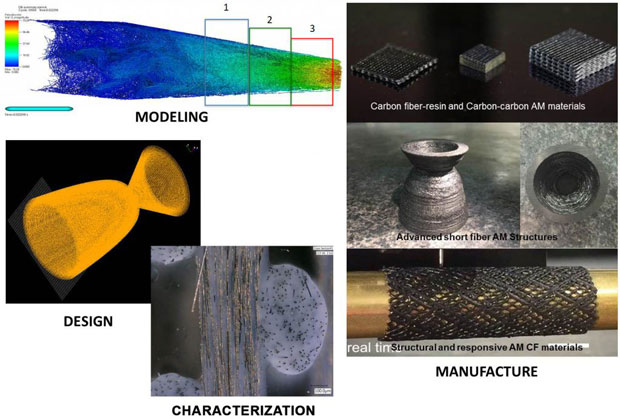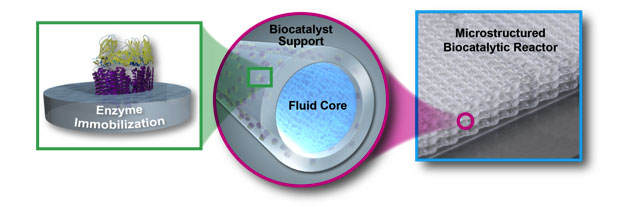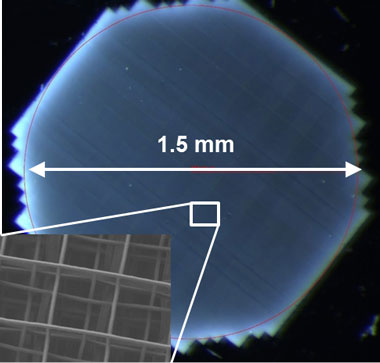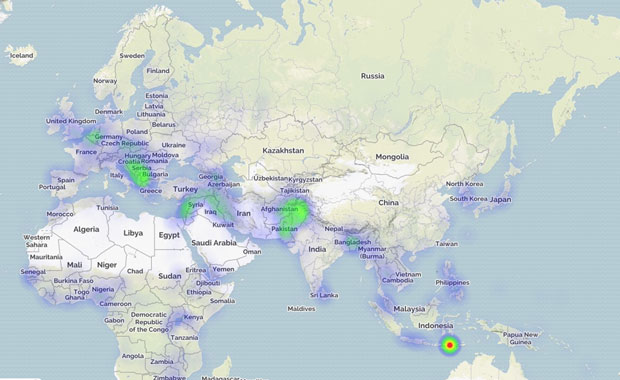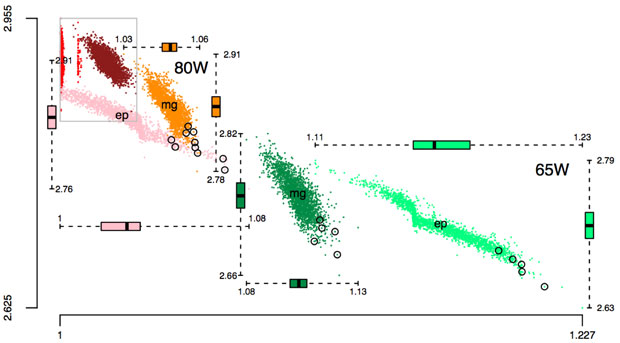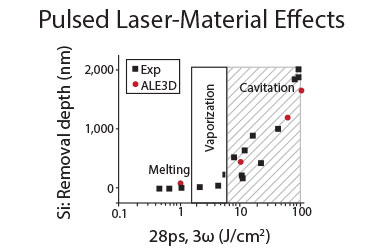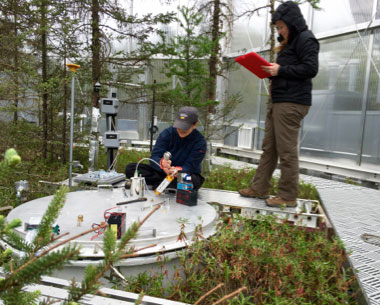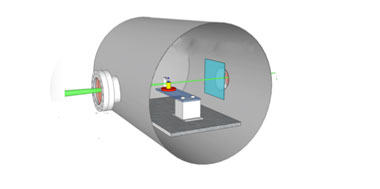This section presents a sample of exploratory research projects from this year’s annual report across a range of research categories and representing various stages of completion. For instance, project numbers that begin with 14 were launched in 2014 and are thus now complete. Project numbers that begin with 15 or 16 were launched in 2015 and 2016, respectively, and as such are midstream.
Mission/Competency: Advanced Materials and Manufacturing
Project: Rational Design and Optimization of Additively Manufactured Carbon-Fiber-Reinforced Composites (15-ERD-030)
Principal investigator: James Lewicki
Summary: Using conductive smart materials, a team of Livermore researchers has demonstrated the 3D printing of shape-shifting structures that can fold or unfold to reshape themselves when exposed to heat or electricity.
Fiber-reinforced composite materials represent a key enabling technology for stockpile management applications that require low weight and high strength or stiffness; however, shortcomings in current design and fabrication methodologies limit our use of these materials. To address this challenge, Livermore researchers leveraged the Laboratory’s expertise in additive manufacturing and characterization to develop 3D printing techniques coupled with specially designed, fiber-reinforced, polymer composites. These new materials and processes will reduce build times, infrastructure, and cost.
Among the many accomplishments achieved during this project, researchers
- developed a high-volume-fraction carbon fiber feedstock that is processable and printable in the direct ink-write process;
- developed an ultrahigh-strength, ultrahigh-temperature resin for carbon fiber direct ink writing;
- designed new print head geometries to improve part production and quality, and designed and tested ultraviolet print heads for continuous fiber printing; and
- significantly improved the optimization of additively manufactured carbon fiber structures.
The significance of this project lies in not only the final products, but also the process by which they were attained. For the first time, researchers applied computational optimization techniques to the rational design and implementation of optimized, fiber-reinforced composite structures produced with additive manufacturing. Researchers demonstrated the ability to produce complex parts with geometries that are unobtainable using conventional manufacturing methods. Furthermore, the resulting products have physical properties that match or exceed those of conventional aerospace-grade carbon-fiber products and have significantly less part-performance uncertainty. The results of this project are of immediate significance to both the Laboratory and to the broader scientific community.
Mission/Competency: Energy and Climate Security
Project: Enzyme-Embedded, Microstructural Reactors for Industrial Biocatalysis (14-ERD-010)
Principal investigator: Sarah Baker
Summary: A team of Livermore researchers developed an efficient, low-cost method for converting methane gas into methanol liquid, as an alternative to burning it off, thereby reducing greenhouse gas emissions.
Methane is a potent greenhouse gas, with about 70-fold higher global warming potential than carbon dioxide. To reduce methane emissions from landfills, wastewater treatment plants, and other “stranded” sources (sources that are small, temporary, or not close to a pipeline), the researchers on this project developed a technology to efficiently convert methane to liquid for further processing using the special enzymes found within methanotrophic bacteria. To maximize the conversion kinetics, researchers embedded the enzyme into a polymer that was then 3D printed into small, flow-through reactors.
The researchers made several innovations during this project, such as
- inventing a new copolymer system;
- demonstrating the first continuous use of the enzyme in a flow-through reactor; and
- devising a manufacturing method to produce the reactors en masse.
This industrial biological methane conversion is projected to have significantly lower energy and capital costs than previous, chemical conversion methods. This project has led to a patent application.
Mission/Competency: High-Energy-Density Science, Advanced Materials and Manufacturing
Project: Accelerated Development of Multiscale Materials (15-ERD-019)
Principal investigator: Juergen Biener
Summary: A team of Livermore researchers is using an innovative approach to developing specialized foam materials for use in high-energy-density physics target fabrication and large-scale electrical energy storage solutions.
Tailored multiscale porous materials have many promising applications ranging from shock absorption to catalysis to energy storage and conversion; however, technical difficulties prevent us from taking full advantage of their potential. Researchers at Livermore are combining additive manufacturing technologies with nature's principles of self-organization, self-assembly, and template capability to enable development and tooling-free integration of monolithic, low-density porous carbons with sub-micrometer feature size and other necessary characteristics.
This research has the potential to
- greatly improve the reproducibility of laser fusion target fabrication;,
- provide new concepts for mitigating hydrodynamic-instability growth for fusion targets; and
- reduce the time associated with the development cycle for these targets.
The new material’s capability also has the potential to create a pathway towards porous structures that mimic nature's functional filtration organs such as the kidney and liver, as well as enable new energy storage and conversion concepts.
Mission/Competency: Cyber Security, Space, and Intelligence
Project: All-Source Data Fusion for Detecting and Monitoring Threats on a Global Scale (15-ERD-050)
Principal investigator: David Widemann
Summary: Researchers are developing improved social-media analytics for faster, more reliable detection of national security threats.
The vast amount of digital information from social networks, e-mail, real-time chat, and blogs offer enormous opportunities for analysts to gain insight into patterns of activity and detection of national security threats. However, systems must be developed to analyze not only the enormous quantity of data, but also the variety of forms that they come in. For this LDRD project, a diverse team of in-house machine-learning and high-performance computing experts are developing just such a system based on novel algorithms that draw connections between different types of data, such as text, images, graphs, process templates, and video. The purpose is to improve analysts' abilities to discover the illicit production of weapons of mass destruction by automatically matching intelligence to process templates created by subject matter experts.
Researchers are developing a system that will
- be scalable to various data sets and incorporate many different data modalities;
- enable cross-modal, context-aware searching;
- automate the prediction of fast-emerging threats; and
- employ a variety of metrics to measure the efficacy of the new system, both at an individual-component level as well as at a threat-detection level.
By moving the burden of integrating the pieces together from the analyst to the machine, a successful project will free analysts to perform high-level decision-making and analysis tasks rather than spend significant time "in the weeds." This will in turn create an improved computational capability to provide decision makers with early warning to threats in a fast-moving, ever-changing intelligence and threat landscape. Developing this capability is well aligned with the strategic focus area of cyber security, space, and intelligence. Our approach will result in better awareness of threats facing the nation, and also supports the Laboratory's core competency in high-performance computing, simulation, and data science.
Mission/Competency: High-Performance Computing, Simulation, and Data Science
Project: Computation Power at Scale (14-ERD-065)
Principal investigator: Barry Rountree
Collaborators: Intel, Oak Ridge National Laboratory, Argonne National Laboratory
Summary: In groundbreaking work, researchers have laid down the conceptual and practical groundwork for exascale computing by optimizing performance within energy constraints.
In recent years, much work in the field of computing outside of the DOE has gone into achieving energy savings, often at the cost of performance. Inside DOE laboratories, however, a priority was placed on “performance-at-all-costs” in order to maximize science done over the lifetime of a given machine. Taking this into consideration along with a growing awareness within the field that power (measured in watts), not energy (measured in watt-hours), will be a first-order design constraint in future exascale systems, a team from Livermore set out to define a new research direction away from energy savings, focusing instead on performance optimization under a power bound. In so doing, they solved the most important problems at hand, by developing a tractable performance model, a working runtime system, a working job scheduler, and software system validation.
This project was designed to perform the basic research required in order to support power and performance components of more applied projects. As such, it has had several notable successes:
- The Laboratory is achieving tangible power savings on existing systems.
- The algorithms created as part of the runtime system are considered best-in-class, and the effectiveness of future runtime systems will be measured against it.
- The research results have led to a cooperative research and development agreement.
- Students funded by this project continue to contribute to the field and the Laboratory.
In meeting their objectives, the team had an impact far beyond their initial expectations, and have successfully transitioned this research to ongoing support from multiple sources.
Mission/Competency: Lasers and Optical Science and Technology
Project: Mechanisms of Pulsed-Laser Ablation, Damage, and Failure in Various Classes of Materials (16-ERD-016)
Principal investigator: Jeffrey Bude
Summary: Researchers are seeking to improve the durability and accuracy of high-powered laser components by studying the material properties of the components.
The pulsed-laser systems used for scientific applications and national security missions often operate under conditions of extreme optical intensity, high average power, or flux density. Depending on how different materials within the laser absorb energy, these conditions can result in degradation and damage to key optical components, limiting system performance and imposing severe constraints on operation. To address these challenges, a team of Livermore researchers is integrating laser material testing, advanced diagnostics, characterization, and simulation to develop a more rigorous theoretical and experimental understanding of pulsed-laser processes in dielectrics, semiconductors, metals, and ion-doped glasses relevant to damage, material failure, ablation physics, and pulsed-laser machining.
Through this project, researchers are
- determining how material properties affect damage;
- identifying wavelength-dependent mechanisms for surface damage; and
- developing simulation models to capture the essential physics of these processes.
By directly addressing stockpile stewardship challenges with cost optimization and utilization of large fusion-class laser systems, and by providing guidance for laser system designs with higher ultraviolet output energy or longer wavelengths, this research project supports the Laboratory's core competency in lasers and optical science and technology. The development of materials for high-average-power systems is relevant to advanced materials and manufacturing and provides new insights into defense-related directed-energy vulnerabilities. In the long run, this project can provide the foundation for new defense and industrial programs as well as the rationale and impetus for new high-average-power pulsed-laser programs.
Mission/Competency: Nuclear, Chemical, and Isotopic Science and Technology
Project: Wetlands as a Source of Atmospheric Methane: A Multiscale and Multidisciplinary Approach (14-ERD-038)
Principal investigator: Karis McFarlane, winner of the 2016 DOE Early Career Award
Collaborator: Oak Ridge National Laboratory
Summary: Using inventive scientific techniques, researchers uncovered significant information about wetland response to climate change and the interrelationship between subsurface water, temperature, microbes, and the carbon cycle.
Boreal peatlands contain large amounts of old carbon, protected by anaerobic and cold conditions. Climate change could result in favorable conditions for the microbial decomposition and release of this old peat carbon as carbon dioxide and methane (greenhouse gases) back into the atmosphere. In fact, natural wetlands currently account for approximately one-third of global methane emissions. Until now, however, predictions of future wetland emissions due to climate change were hindered by a paucity of ecosystem measurements of carbon fluxes, environmental drivers, and links to subsurface processes that influence production and transport of these gases. For this reason, Livermore researchers sought to understand these interacting processes and to test whether peatland response to a warmer climate would include enhanced decomposition of old peat leading to the enhanced release of greenhouse gases. The experiments occurred at the DOE Office of Biological and Environmental Research's Spruce and Peatland Responses Under Climatic and Environmental Change (SPRUCE) project site, a manipulation experiment funded by DOE and located in a forested bog in Minnesota.
As a result of this work, researchers
- discovered new details about the relationship between microbial communities and the carbon cycle, noting which microbes’ response to warming might result in an increased use of old peat carbon;
- conducted the first dual-label experiment using stable isotope probing with nanometer-scale imaging to determine how the local microbes oxidize methane and fix nitrogen gas; and
- determined the role of the subsurface transport of water (and the carbon and nutrients dissolved in it) in microbial activity, findings that are valuable for understanding (and modeling) the interaction of biogeochemistry and hydrology at the bog.
In addition to filling a critical gap in our ability to predict biospheric feedbacks to climate change, the results are relevant to interpreting experimental results and modeling the wetland response to experimental treatments. This work also supported the Laboratory's core competency in nuclear, chemical, and isotopic science and technology by promoting the continued development and early application of specialized techniques in accelerator mass spectrometry and isotope-ratio mass spectrometry. Furthermore, this project highlighted for the DOE community the value that LLNL’s capabilities and expertise in water tracers can provide to large, cooperative experiments like SPRUCE.
Mission/Competency: Stockpile Stewardship Science
Project: Time-Dependent Measurement of Carbon Condensation and Void Collapse in Detonating High Explosives (14-ERD-018)
Principal investigator: Trevor Willey
Collaborators: Los Alamos National Laboratory and Washington State University
Summary: Researchers used novel methods to study high-explosive detonations, disprove old theories, and improve computational models.
Many high explosives contain carbon, which condenses during detonation to produce nanometer-scale allotropes of graphite and diamonds. These carbon allotropes and their particle growth kinetics are neither well known nor easily measured because the optical opacity at the detonation front has, until now, hindered the measurement and study of detonation phenomena at nano-level time and length scales. The resulting lack of experimental data has been a major roadblock to developing more accurate models for high-explosive detonation. Thus a team of Livermore researchers developed a way to measure carbon condensation using time-dependent, small-angle x-ray scattering. They applied this technique in experiments involving a variety of relevant high-explosives that span temperature and pressure conditions, which enabled them to observe dramatically differing morphologies as particles formed. They found that carbon nanometer-scale particulates form on timescales of several tens to hundreds of nanoseconds, rather than over microseconds as previously asserted.
As a result of this project, researchers
- created a capability for acquiring small-angle x-ray scattering and radiographic images from detonation events;
- evolved the capability for several efforts regarding detonator modeling, development, and surveillance; and
- measured carbon condensate morphology and formation kinetics during high-explosive detonation with impacts on a variety of research fields and industries.
This fundamental science research directly benefits U.S. stockpile stewardship, counterterrorism efforts, and the design of advanced conventional munitions. These fields depend upon accurate modeling of various phenomena, including detonation; such detonation modeling requires experimental validation, which this research provides. This work also aligns with the Laboratory's core competency in advanced materials and manufacturing and benefits fundamental materials science by exploring conditions that lead to the formation of nanodiamonds, a material widely used in various biotechnological applications and in seeding synthetic diamond growth.


